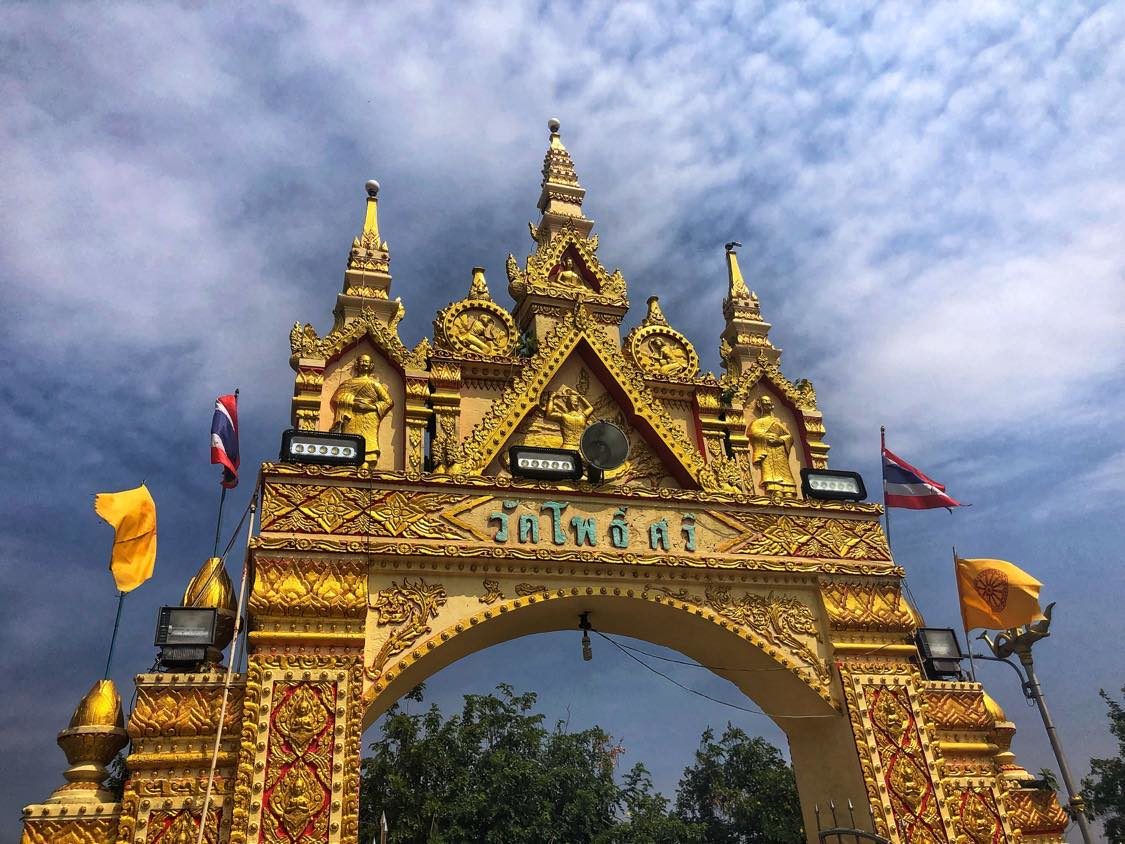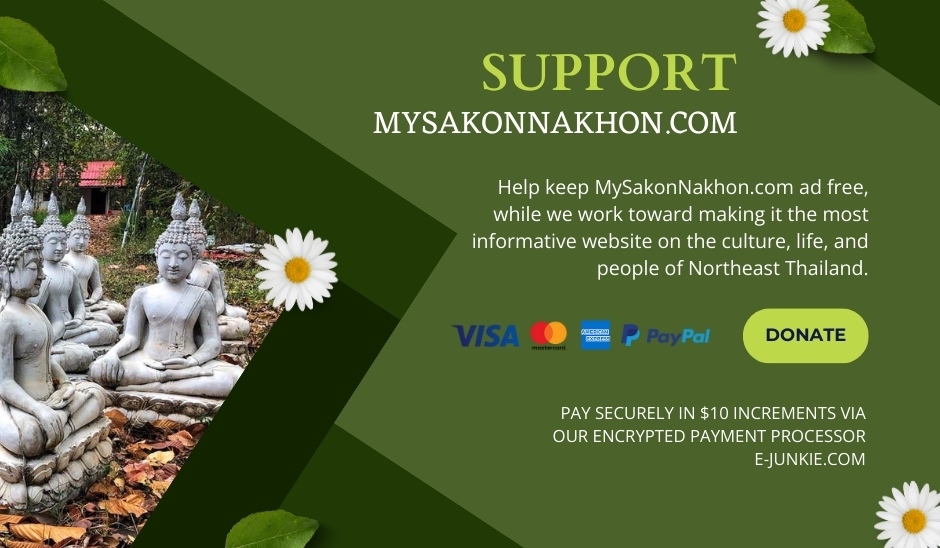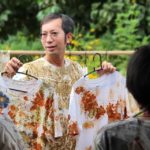
Nakhon Phanom Temples on the Riverfront

If you are visiting the Naga Monument in Nakhon Phanom, you don’t want to stop just there. If you head south down the tree-lined promenade (opposite the direction of the Nakhon Phanom Pier), you’ll find four beautiful Nakhon Phanom temples on the riverfront. The first temple directly across from the Mekhong River is Wat Pho Si (วัดโพธิ์ศรี), also spelled Wat Pho Sri (the letter “r” is silent).
Wat Pho Si’s name translates to The Temple of the Bodi Tree. The name is due to a large Bodhi tree that once existed on the temple grounds (the Bodhi or Bo Tree being of course the tree under which the Buddha achieved enlightenment). The temple was first established in 1801, and is notable for a its bronze cast sculpture of the Buddha named Phra Thong (พระทอง), which translates to the Gold Buddha.
The Phra Thong statue of the Buddha was created in the Lan Xang style in 1523. Lan Xang (or Lan Chang) was a Lao Kingdom that existed from the 14th to the 18th century. Its artisans were noted for creating beautiful bronze statues of the Buddha, of which Phra Thong is a celebrated example. One signature aspect of the style is the Buddha’s ears, which appear almost like curved dishes, symbolizing the Buddha’s ability to hear all the sounds of life, which despite any turbulence find a calm resting place within him.
Phra Thong used to be bathed once a year in a public ceremony during Songkran. However, the Wat Pho Si bathing ceremony now takes place every year on the full moon day of the 6th lunar month in front of the temple. At the end Buddhist Lent, Nakhon Phanom residents will also give a beautiful Buddhist castle made of bees wax to the temple (similar to the ones seen at the Sakon Nakhon Wax Castle Festival).
The next Nakhon Phanom temple on the riverfront is Wat Klang (วัดกลาง), which translates to The Middle Temple, as it is positioned between two nearby temples to the north of it and two temples to the south. The origins of this temple stretches back to 1657. Like Wat Pho Si, the temple grounds of Wat Klang are home to a revered Buddha statue of the Lan Xang period. This bronze Buddha was created in 1788 and goes by the name Phra Ong Tue (พระองค์ตื้อ) or Luang Pu Tue (หลวงปู่ตื้อ). You’ll notice that this Buddha statue has a similar face and the same signature ears as Phra Thong.
Phra Ong Tue is housed within the Ubosot (or Ordination Hall ) of Wat Klang, framed by two large gold pillars and surrounded by small statues of the Buddha. A second Buddha statue which was also created in the 18th century is housed within the temple’s Mondop. This Lan Xang Buddha appears along with two statues of Phra Sangkachai (พระสังกัจจาย) — the “fat Buddha” figure who often is confused with the Chinese laughing Buddha known as Budai. Phra Sangkachai is believed to have come from Burma. He is recognized throughout Southeast Asia as a figure who can provide monks with abundant harvests and business people with success and wealth. Thus you’ll see prominent donation boxes here where followers place money to make merit.
Keep walking south about 200 meters and you’ll arrive at the third Nakhon Phanom temple on the riverfront: Wat Maha That (วัดมหาธาตุ), which was once the residence of the Supreme Patriarch or leader of Thailand’s Buddhist monks. With sacred grounds that stretch back to 607 AD, Wat Maha That is the most revered temple in Nakhon Phanom City, with the Wat Okat temple (which is just a little north of the Naga Monument) being a close runner-up. Wat Maha That is immediately recognizable for its tall, white Chedi, which is a replica of the famous Phra That Phanom Chedi, the most scared site in Nakhon Phanom province, and one of the most revered Buddhist sites in all of Thailand.
The Chedi at Wat Maha That is known as Phra That Yasothorn, as well as Phra That Anon — the latter name being derived from Phra Anon, a Vientiane official who is said to have brought settlers to the Nakhon Phanom region centuries ago, and whose relics are housed within the Chedi. Phra That Yasothorn, which measures 24 meters high, was built from 1920-1922 by a Vientiane army general named Phraya Maha Ammat. In addition to the relics of Phra Anon, it houses the relics of important Buddhist monks and revered bronze Buddha statue.
At the entrance to Wat Maha That, you’ll notice a statue of what appears to be a Naga serpent being eaten by some kind of fierce aquatic creature. This creature comes from Hindu mythology and is known as a Makara. It is not actually eating the Naga serpent (which it likely wouldn’t have the power to do, even if it wanted to). The Naga is instead emerging from the mouth of the Makara. This symbolizes the birth of Buddhism from the Hindu legends that preceded it. The Makara/Naga are guardian figures of many Nakhon Phanom temples. You’ll also see them also at Wat Klang and Wat Pho Si.
The southernmost Nakhon Phanom temple on the riverfront is Wat Phra In Plaeng (วัดพระอินทร์แปลง), which means the Temple of Indra. You’ll see a very dark green statue of Indra sitting atop Wat Phra In Plaeng’s gorgeous entrance gate, with the head of the Buddha in his lap. The story behind this revolves around the temple’s most sacred Buddha statue named Luang Pho Phra In Plaeng (หลวงพ่อพระอินทร์แปลง). It’s said that in 1390 a Lan Xang artisan created the bronze body of the Buddha statue, but failed in perfecting the head. He tried repeated times, but could never complete it to his liking, so he abandoned the headless Buddha statue. The villagers and a Buddhist abbot dug a tunnel in which they buried the statue.
Centuries later in 1850 a temple around the tunnel called Wat Umong (วัดอุโมงค์) was built, the name meaning The Tunnel Temple. At some point after that the abbot of the temple had a vision of Indra descending from the heavens and fashioning a beautiful head for the buried Buddha statue. The abbot then hired a craftsman to create a head for the Buddha, following closely what the abbot saw in his vision. They used a special bronze allow mixed with gold to create its shimmering green finish which contrasts beautifully with the gold body. The name of the temple was then changed to Wat Phra In Plaeng.
The most visually rich of all 5 Nakhohn Phanom temples (including Wat Okat on the Northern end), Wat Phra In Plaeng has statues of Hindu mythological figures not seen at the other 4 temples (such as the half elephant, half lion figure known as Khochasi), plus gorgeous examples of the Buddhist Naga taking its half-human, half-serpent form. Having completed your temple tour, you might like to drop by the nearby Tree Restaurant on the Mekhong River, before walking back up the promenade. The food is excellent and the atmosphere lovely.
If you are staying in Nakhon Phanom for several days during your Thailand holiday, we would suggest taking a day trip to visit some of the beautiful mountain and forest temples of Sakon Nakhon. Read a little bit more about this neighboring province at Sakon Nakhon History.
- Thai Inhalers: Boost Your Memory & Recall with “Ya Dom” - May 18, 2024
- Phra Khun Paen: Thai Love Spells & Amulets - May 17, 2024
- Visakha Bucha Day in Thailand (2024) - May 16, 2024




